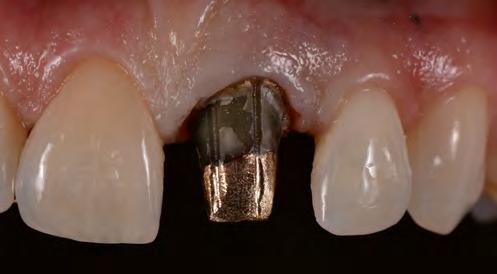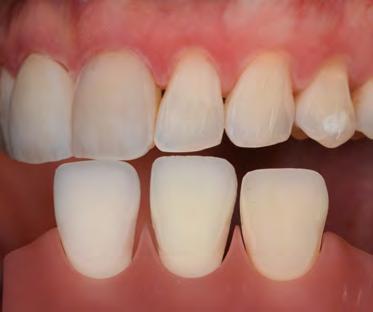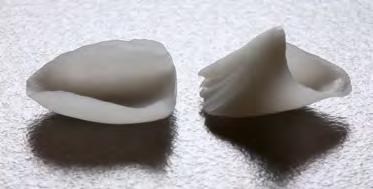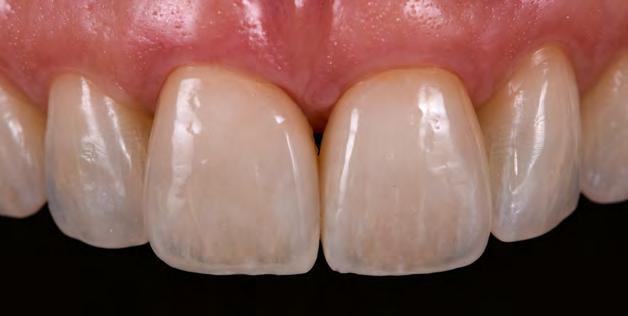
8 minute read
Esthetic results even on discoloured substructures
Value and brightness control with the IPS e.max system By Dr Tony Rotondo, Brisbane/Australia, and Szabolcs Hant, MDT, Perth/Australia
The correct brightness level is essential for the success of ceramic veneer restorations. This can be an issue, especially if discoloured preps are involved.
Advertisement
It is quite common for the prosthetic restorative team to be faced with discoloured preps, which, if located in the visible esthetic zone, require a well-considered approach. The question at the core is: How can we integrate the discoloured tooth structure into our layering work in a way that a balance between an effective “coverage” and a vibrant interplay of shades is achieved (Figs 1 and 2)? The approach outlined below is based on a clearly defined treatment itinerary consisting of the following stages: 1. Space requirement for masking
with all-ceramic restorations
2. Material selection 3. Masking with framework 4. Masking with staining material (IPS Ivocolor ® )
5. Layering with ceramic materials
(IPS e.max ® Ceram)

01 — These images highlight the inherent structure of natural teeth. It is the job of the dental technician to replicate these characteristics.
02 — To replicate the dentition in this case, Power Dentin is used for the opaque area and Dentin for the more translucent part.


05 04

03 — The metal core build-up is to be restored with a crown.
04 — The coping is first masked with one layer, in total with three layers, of IPS Ivocolor Essence White. Available space: 1.1mm
05 — The metal post is effectively masked. The brightness and value of the crown blends in with the natural dentition optimally.
Sufficient space is essential to place all-ceramic restorations on discoloured preps if we want to mask the discolouration and attain a natural shade effect and the desired brightness (Figs 3 to 5). We can calculate the space required for the all-ceramic restoration with a formula proposed by Aki Yoshida and Galip Gürel as follows: We take the minimum thickness of an all-ceramic framework and add 0.15 mm by every shade we want to increase the brightness.
For example:
Discoloured prep: shade A4 Goal for the final crown: A1 Minimum thickness of IPS e.max Press: 0.4mm Space required for the restoration: 4 x 0.15 + 0.4 = 1 mm
Another method is to use the SNA app (IPS e.max Shade Navigation App). This app establishes the translucency and shade based on the starting situation.
2. Selecting the framework material
Our material of choice has been IPS e.max Press for the past twelve years and we have had excellent experiences with it. We usually use the MO 0, LT and MT press ingots. If we happen to use the LT ingot, we always select an ingot that is one shade brighter for the framework, for example a BL4 for a final A1 shade. This is discussed in more detail in the section on “Layering” below. Under normal circumstances, these ingots are ideal. However, if the prep is severely discoloured, the situation is more complicated. In these cases, the discoloured tooth structure must be disguised.
We differentiate between two methods for masking: Masking with the framework Masking with staining material (IPS Ivocolor)
3. Masking with framework
If the framework is used to mask the discoloured tooth structure, the options are limited. The masking capabilities will depend on the thickness of the framework and not only on the material chosen. MO ingots can easily block out discoloured substrates if they are used in an adequate thickness of 0.5 to 0.7 mm. In many cases, however, there is not enough space or the shade of the prep is too dark. Another method is to use HO ingots or zirconia frameworks for masking. However, these materials are extremely opaque, making it hard to create a natural illusion of depth and translucency in the incisal area.
4. Masking with staining material (IPS Ivocolor)
The Ivocolor range of stains and glazes includes some amazing materials. Given their unique properties, the Enamel and Effect materials are suitable for both metal-ceramic and all-ceramic restorations. Another advantage we like is the low firing temperature. The low-fusing Glaze and Essence materials helped us many times to adjust a contact point or to add more chroma and effects at the correction firing, without compromising the shape or texture.
We need a framework to use this technique. Any framework material will do in conjunction with the IPS Ivocolor range. Initially, we always used the MO 0 ingots. Then we realized that the LT and MT ingots generate similar masking effects, whilst providing superb full-contour lingual surfaces. IPS Ivocolor Essence White can be easily used as a basic white stain (Figs 6 to 9). We fire three separate layers because one thick layer can shrink too much during the firing process, causing uneven surfaces and cracks from the shrinking. With three layers of IPS Ivocolor Essence White, even severely discoloured areas can be masked without reducing the space required for the layering. These three layers of staining material are usually only between 0.1 and 0.15mm thick. Other Essences can be added to the basic white stain to achieve an even closer match to the final shade. In so doing, however, you should bear in mind that the more translucent materials you mix in, the less effective the masking effect is. For example, IPS Ivocolor Essence Cream contains translucent particles that reduce the opacity of the mixture. If you are not sure about the level of opacity you are getting, you can dilute the mixture with stain liquid or benzyl alcohol and then check with a magnifying glass (10 to 20-times magnification). We normally use IPS Ivocolor Essence Sunset to add chroma to the white stain. Alternatively, you can also just use pure white at this stage and increase the chroma at the next stains firing. Stains are fired at a firing temperature of 750°C using the dentin firing program.
5. Layering with IPS e.max Ceram
Layering is also an important factor to cover discoloured preps and to achieve a high level of brightness and chroma. Originally, the IPS e.max layering ceramic was developed for opaque, high value framework materials, such as the HO and MO ingots and the first generation of zirconia materials. On these high-value frameworks, IPS e.max Ceram worked beautifully. Problems started to arise when the LT and HT ingots were introduced. How could you combine the translucent IPS e.max Ceram layering ceramic with the translucent LT and HT framework materials? All of a sudden, the usual layering technique did not work any longer, leaving dental technicians confused and frustrated – and so were we. Then we discovered the key element for successful restorations: brightness-value-opacity. We learned a great deal by experimenting with different combinations of materials. For some time, our principle has always been to use Mamelon Light Impulse – a material that features a high level of opacity and fluorescence and goes a long way towards achieving a lifelike result. In the meantime, the IPS e.max Ceram system has been extended to include the new Power Dentin and Power Incisal range of materials. These materials allow users to achieve a natural opacity without mixing different materials. If the framework is white and/ or opaque, the first generation of Deep Dentin/Dentin/Incisal materials can still be used. If the frameworks are made of LT, MT or other translucent material, the new Power materials are used best (Figs 10 to 14).


07 06 — This case also involves a severely discoloured prep.
07 — LT framework masked with IPS Ivocolor Essence White
08 — A photograph (polarizing filter) is taken at the try-in to verify the brightness. 08


09 — Both crowns in situ 09

11 — Dental photographs assist in analysing the initial situation.


12 11b

12 — The frameworks have been pressed from a MT ingot and masked with IPS Ivocolor Essence White.
13 — Try-in after the first firing
14 — Both ceramic restorations in situ

14
Conclusion
The correct brightness is essential for successful esthetic results. The framework material should be selected carefully, especially for all-ceramic restorations. With the IPS e.max system, this is relatively easy, even in difficult cases. It is advisable to first determine the shade of the preparation and the space available for the restoration and then select the framework material. The IPS e.max Shade Navigation app (SNA app) is a useful tool for dentists and dental technicians in doing this. With the above presented approach, we can restore most cases of severely discoloured tooth structure with ceramic restorations that harmoniously and smoothly blend in with the natural dentition.

Szabolcs Hant, MDT Szabi Hant - Hant Dental 32A Bombard street, Ardross, 6153 Perth Western Australia
Dr Tony Rotondo Level 4, 106 Edward St 4000 Brisbane QLD Australia
E A R L Y B I R D · E A R L Y B I R D · E A R L Y B I R D · E A R L Y B I R D · E A R L Y B I R D · GET YOUR TICKETS NOW!
INTERNATIONAL EXPERT SYMPOSIUM 12 and 13 June 2020 SEE YOU IN PARIS!
SUCCEEDING TOGETHER IN TOMORROW’S DENTISTRY
Excellent programme, unique locations, networking opportunities: Be part of it!
LE CARROUSEL DU LOUVRE
Prof. J-P. Attal A. Bruguera Dr A. Casucci V. Fehmer Prof. P. Gierthmühlen Dr E. Guzmán Dr P. Hajný Prof. R. Hirata A. Ielasi Prof. S. Koubi Prof. I. Sailer Dr T. Sastre Prof. G. Tirlet Dr R. Turrini G. Ubassy D. Vinci
Keynote lecture: Dr Bertrand Piccard
In collaboration with:





